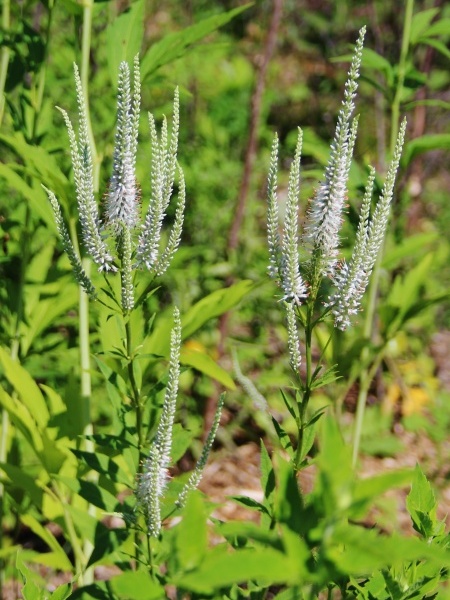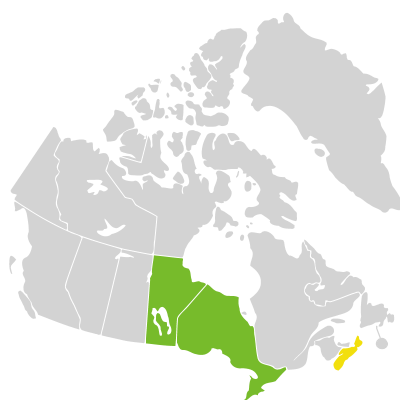 Known to be toxic - Toxic to mammals if ingested.
Known to be toxic - Toxic to mammals if ingested.

Source: Sundaura Alford-Purvis
Veronicastrum virginicum
Culver's Root
Véronique de Virginie
Synonyms
Virginia Culver's root
véronicastre de Virginie
Seeds in stock
Available at table Mixed Sun, Dry
Available at table Mixed Sun, Dry
We currently accept seeds for this plant
Bloom Colour: White
Bloom Period: Jun - Sep
Max Height: 5.0 feet
Max Width: 3.0 feet
Light Condition:
 More than 6 hours of direct sun a day
More than 6 hours of direct sun a day
 More than 2 or 3 hours but less than 6 hours of direct sun a day
Soil conditions:
More than 2 or 3 hours but less than 6 hours of direct sun a day
Soil conditions:
 Tolerates dry soil condition
Tolerates dry soil condition
 Tolerates medium soil condition
Tolerates medium soil condition
 More than 6 hours of direct sun a day
More than 6 hours of direct sun a day
 More than 2 or 3 hours but less than 6 hours of direct sun a day
More than 2 or 3 hours but less than 6 hours of direct sun a day
 Tolerates dry soil condition
Tolerates dry soil condition
 Tolerates medium soil condition
Tolerates medium soil condition
Lifespan:
Perennial
plants that will that come back year after year
Gardener Experience:
 Suitable for beginner gardeners
Suitable for beginner gardeners
 Does not spread uncontrollably
Does not spread uncontrollably
 Self-seeding
Self-seeding
 Suitable for beginner gardeners
Suitable for beginner gardeners
 Does not spread uncontrollably
Does not spread uncontrollably
 Self-seeding
Self-seeding
Landscape Uses:
 Suitable for rain gardens
Suitable for rain gardens
 Suitable for shoreline rehabilitation
Suitable for shoreline rehabilitation
 Suitable for container garden
Suitable for container garden
 Suitable for rain gardens
Suitable for rain gardens
 Suitable for shoreline rehabilitation
Suitable for shoreline rehabilitation
 Suitable for container garden
Suitable for container garden
Ecological Benefits:
No ecological benefits information available.
Tolerates:
 Deer resistant
Deer resistant
 Rabbit resistant
Rabbit resistant
 Tolerates limestone conditions
Tolerates limestone conditions
 Tolerates sandy conditions
Tolerates sandy conditions
 Tolerates acidic soil conditions
Tolerates acidic soil conditions
 Tolerates transplantation
Tolerates transplantation
 Deer resistant
Deer resistant
 Rabbit resistant
Rabbit resistant
 Tolerates limestone conditions
Tolerates limestone conditions
 Tolerates sandy conditions
Tolerates sandy conditions
 Tolerates acidic soil conditions
Tolerates acidic soil conditions
 Tolerates transplantation
Tolerates transplantation
Special Features and Considerations:
 This plant is endangered
This plant is endangered
 This plant is endangered
This plant is endangered
Plant Location
Distribution according to VASCAN

Ephemeral
Native
Introduced
Excluded
Extirpated
Doubtful
Absent
Thrives in Ecozones
- Atlantic Maritime
- Boreal Plains
- Mixed Wood Plains
Ecological Benefits
Butterflies Supported by Veronicastrum virginicum
No butterfly data available for this plant.
Specialized Bees Supported by Veronicastrum virginicum
No bee data available for this plant.
Plants that grow in similar conditions, that bloom at the same time.
Complementary Plants
- Agastache foeniculum
Blue Giant-hyssop
Agastache fenouil - Andropogon gerardi
Big Bluestem
Barbon de Gérard - Heliopsis helianthoides
False Sunflower
Héliopsis faux-hélianthe - Solidago juncea
Early Goldenrod
Verge d'or jonciforme - Symphyotrichum oolentangiense
Sky Blue Aster
Aster azuré
Substitute For Non-Native Plants
- Sorbaria sorbifolia (False spirea)
- Aruncus dioicus (Goat's Beard)
- Buddleia (Butterfly Bush)
- Melilotus albus (Sweet White Clover)
Sowing Information
Download Seed Envelope Labels (PDF)
- Sowing depth: Surface sow
- Sow anytime
- Stratification duration: 0 days
- Self-seeding
- Notes: Can be sown in late spring in warm soil.
Harvesting and Seed Sharing
- Harvest start month: September
- Harvesting indicator:
- Pods are brown, seeds are dark, and crisp, and little stem connecting the pod to the main stem is brown (not green)
- Harvesting:
- Cut stem (including pods), let air dry in paper bag, then shake seeds off after a few days
- Seed viability test:
- No test needed before donating
- Packaging measure: 1 rounded 1/32 teaspoon
- Seed storage:
- Air dry in paper bag or open container, for a few days until crisp
- Shake seeds to move them once in a while to prevent molding
- Cultivar: Yes, do not donate unless you know source, and there are no known cultivars in your garden or at proximity
- No harvesting video available at this time.
Toxicity Notes
Toxic to mammals if ingested.


 Canadensis
Canadensis
